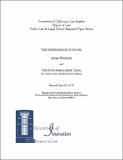|
Reseña:
|
Reseña:We want to consider what judicial independence means from an introspective ange - from the inside-out as it were, seen through the judges' eyes. An introspective approach seeks to understand judicial independence not by reference to the structural organization of the three branches of government, but by reference to the judge's own perception of her ability to adjudicate cases. Our model is a self-reflective judge... Judges occupy a place of high tension, located at the intersection of numerous different restraints and liberties. An introspective understanding indicates that structural arguments are incompatible because they focus solely on the threat posed to the judiciary by the other two branches of government, ignoring what is made clear by introspection, the threat to independent adjudication posed by and within the judiciary itself. An introspective approach also shows that many forms of constraint felt by judges that interfere with independent adjudication exist beyond the realm of law and legal doctrine, partaking of the realm of culture. Finally, it shows that the structure of the Constitution... is simply one part of the foundation of independence... |



